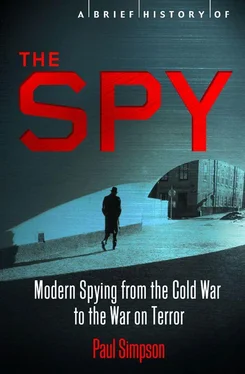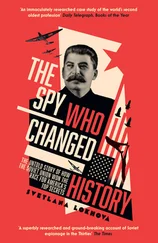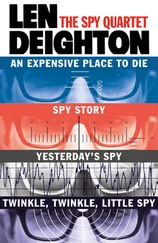Paul Simpson - A Brief History of the Spy
Здесь есть возможность читать онлайн «Paul Simpson - A Brief History of the Spy» весь текст электронной книги совершенно бесплатно (целиком полную версию без сокращений). В некоторых случаях можно слушать аудио, скачать через торрент в формате fb2 и присутствует краткое содержание. Город: London, Год выпуска: 2013, ISBN: 2013, Издательство: Constable & Robinson, Жанр: Прочая документальная литература, на английском языке. Описание произведения, (предисловие) а так же отзывы посетителей доступны на портале библиотеки ЛибКат.
- Название:A Brief History of the Spy
- Автор:
- Издательство:Constable & Robinson
- Жанр:
- Год:2013
- Город:London
- ISBN:9781780338910
- Рейтинг книги:3 / 5. Голосов: 1
-
Избранное:Добавить в избранное
- Отзывы:
-
Ваша оценка:
- 60
- 1
- 2
- 3
- 4
- 5
A Brief History of the Spy: краткое содержание, описание и аннотация
Предлагаем к чтению аннотацию, описание, краткое содержание или предисловие (зависит от того, что написал сам автор книги «A Brief History of the Spy»). Если вы не нашли необходимую информацию о книге — напишите в комментариях, мы постараемся отыскать её.
A Brief History of the Spy — читать онлайн бесплатно полную книгу (весь текст) целиком
Ниже представлен текст книги, разбитый по страницам. Система сохранения места последней прочитанной страницы, позволяет с удобством читать онлайн бесплатно книгу «A Brief History of the Spy», без необходимости каждый раз заново искать на чём Вы остановились. Поставьте закладку, и сможете в любой момент перейти на страницу, на которой закончили чтение.
Интервал:
Закладка:
According to KGB files, for the next two years, Dalibar Valoushek tried to inform Moscow Centre that he was now a double, but no one took any notice. The FBI tried to use him to put pressure on Hambleton in 1980, but the latter was confident that he could not be arrested. ‘A spy is someone who regularly gets secret material, passes it on, takes orders, and gets paid for it,’ he said at the time. ‘I have never been paid.’ The RCMP and the Canadian Ministry of Justice tried to bring charges, but found insufficient evidence. Hambleton was eventually arrested when visiting London in 1982.
Three key KGB agents provided material throughout the seventies: two in the US, one in Europe. John Anthony Walker, Karl Koecher and George Trofimov were all busy during this period, passing classified information often in exchange for large sums of cash.
Walker had volunteered his services to the Soviets in 1967 when he was working in the communications room for the US Navy’s submarine operations in Norfolk, Virginia: ‘I’m a naval officer,’ he told staff at the Soviet embassy in Washington. ‘I’d like to make some money and I’ll give you some genuine stuff in return.’ The first item he stole was a key list for an old cryptographic machine — which, it was later suggested, led directly to the North Koreans’ desire to capture the US spy ship, the USS Pueblo , a month later — and from there on photographed multiple documents, claiming sarcastically that ‘K Mart has better security than the Navy’. Although Walker retired from the Navy in 1976, he had already recruited his friend Jerry Whitworth, and later brought in his own son and elder brother so that the work could continue.
Karl Koecher and his wife Hana, meanwhile, were actively working for the KGB from within the CIA. The pair were originally Czech StB agents sent across as illegals in 1965; they had broken off contact with the StB in 1970, but tried to build bridges with their former employers in 1974, a year after Karl had begun working in the CIA’s Soviet division. This brought them to the attention of the Soviets, who took over their case. Highly sexually active (and apparently with all the allure of Mike Myers’ spoof spy Austin Powers — ‘a terrible lover’ according to one report), Koecher was able to pass on compromising information on Washington officials, as well as classified Soviet and Czech material. Koecher went freelance in 1975 but continued to supply the KGB, passing on information that would compromise the CIA’s Moscow asset Aleksandr Ogorodnik in 1977.
George Trofimov was a retired US Army colonel based in Germany as a civilian who in 1969 became Chief of the United States Army Element at the Nuremberg Joint Interrogation Centre, giving him access to very high levels of documents. He was recruited to the KGB by his boyhood friend, Igor Vladimirovich Susemihl, a bishop in the Russian Orthodox Church. This wasn’t as unusual as it might sound: the KGB often used the church and its officials within its schemes. Throughout the seventies and eighties — and until his retirement in 1995 — Trofimov sent material to Moscow via Susemihl, who continued to rise within the Orthodox Church, eventually achieving high rank as the Metropolitan of Vienna.
West Germany was a useful source of information for the Soviets. The ‘secretaries initiative’ continued to reap dividends. Margret Hîke passed on information from the office of the West German president from 1968 throughout the seventies, in exchange for 500 marks a month and expenses. Using a camera disguised as a tube of lipstick, she gave the KGB ten volumes of documents between 1968 and 1980, including mobilization plans, details on the government war bunker, and accounts of the president’s meetings with foreign diplomats.
Heidrun Hofer, a secretary in the BND, was seduced by an East German illegal who claimed to be part of a neo-Nazi group of German patriots; she continued to spy even after deducing she was working for the KGB. She was arrested in 1977 and tried to commit suicide when her unsuspecting BND fiancé broke off their engagement as a result of her confession.
Elke Falk was equipped with a camera disguised as a cigarette lighter and a fake can of hairspray to put her films in. Working initially in the West German chancellor’s office after her recruitment in 1974, she was transferred to the transport ministry in 1977 and then to the economic aid ministry two years later.
In France, the KGB’s longest-serving agent, ‘Jour’, continued to impress, singled out for a large bonus personally approved by KGB chief Andropov between 1973–75. The cipher clerk at the Foreign Ministry was recruited by the Soviets at the end of the Second World War and allowed Moscow to read French SIGINT, including their discussions with their embassies during the Cuban Missile Crisis. New teleprinters installed in the French Embassy in Moscow over the winter of 1976 were bugged thanks to his information, and he continued to assist with recruiting new agents right to the end of his thirty-seven year career as a Soviet spy.
The Italian Embassy in Moscow was one of the KGB’s key targets, and ‘swallows’ were used to honey trap key employees. Some of these, including a senior diplomat codenamed both Artur and Arlekino, were then used as spies within Italy itself. The KGB also targeted scientific personnel, with code name Uchitel (‘Teacher’) able to pass valuable intelligence on military aircraft, helicopters and guidance systems, including information on the new Tornado plane being jointly developed by Germany, Italy and Great Britain.
One of the KGB’s more successful agents travelled around Europe using seduction and romance as a weapon to gain information from unsuspecting targets. Ex-Metropolitan Police Detective Sergeant John Symonds had gone on the run in 1972 while awaiting trial at the Old Bailey on charges of corruption, and had approached the KGB via the Soviet embassy in Rabat. ‘I was taught how to be a better lover,’ he told the BBC in 1999. ‘Perhaps I wasn’t a very good one before, I don’t know. But it was very pleasant. I was taught by two extremely beautiful girls. That was quite an interesting part.’ After this training, he was sent to Bulgaria where he seduced the wife of a West German official; Africa, where he targeted women at the American and British missions; Moscow, India, Singapore, and Australia. Eventually when he could no longer turn his good looks to his advantage, he decided to surrender to British justice. He made no mention of his espionage activities, and was simply charged with corruptly taking £150 from a London criminal. Although he later tried to persuade the British authorities of his KGB work, he wasn’t believed and his spying activities only came to light when Vasili Mitrokhin passed over his material from the KGB archives in 1992. However by then, he had been given immunity from prosecution in return for giving evidence in other cases. As of this writing, a movie based on his exploits is in pre-production.
Although the official policy of the KGB since the early sixties had been to use assassination sparingly as a weapon, there were times that it was deemed necessary. Moscow Centre assisted the Bulgarian secret service, the Duzhavna Sigurnost, with the murder of a particularly troubling dissident intellectual, Georgi Markov. The assassination has entered into folklore for its method: Markov was stabbed with poison concealed within the tip of an umbrella.
Earlier in his career, Markov had been a protégé of the Bulgarian President, Todor Zhivkov, but he had defected to Britain in 1969. Working for the BBC World Service, Radio Free Europe and German station Deutsche Welle, Markov verbally attacked Zhivkov. In early 1978, the head of the DS, General Dimitar Stoyanov, requested help from Moscow, and reluctantly KGB chief Yuri Andropov agreed that the KGB would provide the means for the assassination, but not the agent to carry it out. ‘Give the Bulgarians whatever they need, show them how to use it and send someone to Sofia to train their people. But that is all,’ he ordered the Operational Technical Directorate.
Читать дальшеИнтервал:
Закладка:
Похожие книги на «A Brief History of the Spy»
Представляем Вашему вниманию похожие книги на «A Brief History of the Spy» списком для выбора. Мы отобрали схожую по названию и смыслу литературу в надежде предоставить читателям больше вариантов отыскать новые, интересные, ещё непрочитанные произведения.
Обсуждение, отзывы о книге «A Brief History of the Spy» и просто собственные мнения читателей. Оставьте ваши комментарии, напишите, что Вы думаете о произведении, его смысле или главных героях. Укажите что конкретно понравилось, а что нет, и почему Вы так считаете.












